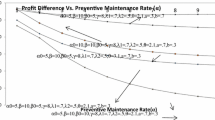Abstract
An attempt to capture software aging and specify when to do preventive maintenance (PM) is presented in this paper. A composite measure termed the DRM, Deteriorating Response Measure, is defined. It is based on the analysis of the deteriorating speed of the software against time and load. This speed is characterized as follows: (1) It decays with increased load. (2) It does not increase again when the load decreases, this indicates “loss of elasticity.” The DRM is mathematically formulated based on a queueing system model.
Specifying when to do preventive maintenance depends on the decision maker's perspective of the manifestation of aging. It is tried here to formalize this dependence. Three degrading performance metrics are defined for a DRM: (1) Decaying restored speed value. (2) Increasing speed offset ratio (recoverability index). (3) Increasing operation interval offset. These metrics can be used singly or aggregately in a DRM to specify when to do preventive maintenance. Results of model testing are also shown.
This work can be part of an on-line procedure that calculates performance indexes for a server type software system like a web browser, an operating system, a database, and helps in the decision to do preventive maintenance for aging software.
Similar content being viewed by others
References
Avizienis, A. 1985. The n-version approach to fault-tolerant software, IEEE Transactions on Software Engineering 11(12): 1419–1501.
Bernstein, L. 1996. Text of seminar delivered at the university learning center, George Mason Univ., Jan. 29.
Edams, E. 1984. Optimizing preventive service of the software products, IBM J. Research and Development 28(1): 2–14.
Garg, S., Huang, Y., Kintala, C., and Trivedi, K.S. 1995a. Time and load based software rejuvenation: Policy, evaluation and optimality, In Proc. of 1st Fault-Tolerant Symp., Madras, India, Dec.
Garg, S., Huang, Y., Kintala, C., and Trivedi, K.S. 1996. Minimizing completion time of a program by check-pointing and rejuvenation, In Proc. of 1996 ACM SIGMETRICS Conf., Philadelphia, May, pp. 252–261.
Garg, S., Puliafito, A., Telek, M., and Trivedi, K.S. 1995b. Analysis of software rejuvenation using Markov regenerative stochastic Petri net, In Proc. of 6th International Symp. Software Reliability Eng., Toulouse, France, Oct., pp. 24–27.
Garg, S., Puliafito, A., Telek, M., and Trivedi, K.S. 1998a. Analysis of preventive maintenance in transactions based systems, IEEE Transactions on Computers 47(1): 96–107.
Garg, S., Van Moorsel, A., Vaidyanathan, K., and Trivedi, K.S. 1998b. A methodology for detection and estimation of software aging, In Proc. of the 9th International Symposium on Software Reliability Engineering, Paderborn, Germany, Nov., pp. 282–292.
Gross, D. and Harris, C.M. 1974. Fundamentals of Queueing Theory, John Wiley and Sons, New York.
Huang, Y., Kintala, C., Kolettis, N., and Fulton, N.D. 1995a. Software rejuvenation: Analysis, module and applications, In Proc. of 25th Symp. Fault-Tolerant Computing, Pasadena, CA, June, pp. 381–390.
Hwang, Y., Jalote, P., and Kintala, C. 1994. Two Techniques for Transient Software Error Recovery, Lecture Notes in Computer Science, Vol. 774, Springer, Berlin, pp. 159–170.
Hwang, Y., Jalote, P., and Kintala, C. 1995b. A framework for understanding and handling transient software failures, In Proc. of 2nd ISSAT International Conference on Reliability and Quality in Design, Orlando, FL.
Lehman, M.M. 1974. Programs, Cities, Students, Limits to Growth?, Inaugural Lecture, May. Published in Imp. Col of Sc. Tech. Inaug. Lect. Ser., Vol. 9, 1970, pp. 211–229. Also in D. Gries (ed.), Programming Methodology, Springer, 1978, pp. 42-62.
Lehman, M.M. 1978. Laws of program evolution-rules and tools of programming management, In Proc. of Infotech State of the Art Conf., Why Software Projects Fail?, Apr. pp. 11/1–11/25.
Lehman, M.M., Kahen, G. and Ramil, J.F. 2000. Replacement decisions for e-type software-some elements, In ICSE'2000 Second Workshop on Economics-Driven Software Engineering Research, Limerick, Ireland, June.
Marshall, E. 1992. Fatal error. How patriot overlooked a scud, Science (March): 1347.
Parnas, D.L. 1994. Software aging, In Proc. of the 16th International Conference on Software Engineering, Sorrento, Italy, May 16-21, pp. 279–287.
Pfening, A., Garg, S., Puliafito, A., Telek, M., and Trivedi, K.S. 1996. Optimal rejuvenation for tolerating soft failures, Performance Evaluation 27/28 (Oct.): 491–506.
Tai, A., Chau, S.N., Alkalaj, N., and Hecht, H. 1997. On-board preventive maintenance: Analysis of effectiveness and optimal duty period, In Proc. of 3rd International Workshop Object-Oriented Real-Time Dependable Systems, Feb.
Vaidyanathan, K. and Trivedi, K.S. 1999. A measurement-based model for estimation of resource exhaustion in operational software systems, In Proc. of the 10th IEEE International Symposium on Software Reliability Engineering, Boca Raton, FL, Nov., pp. 84–93.
Vardeman, S.B. 1994. Statistics for Engineering Problem Solving, PWS Publishing Company.
Author information
Authors and Affiliations
Rights and permissions
About this article
Cite this article
Ghoneim, S.A., Fahmy, H.M.A. Evaluation of the DRM and the Time for Preventive Maintenance for Aging Software. Software Quality Journal 11, 57–75 (2003). https://doi.org/10.1023/A:1023636112886
Issue Date:
DOI: https://doi.org/10.1023/A:1023636112886




